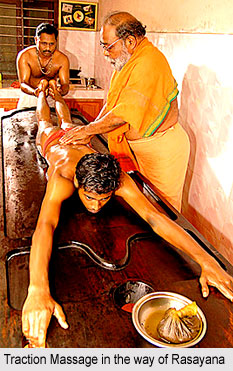 Rasayana is a well-developed science. Literally, Rasayana means the augmentation of rasa. This "rasa" is the vital fluid produced by the digestion of food, which sustains the body through the strengthening of the dliatus. It is the rasa flowing in the body which sustains life. When it stops flowing, life comes to an end. Rasayana is, therefore, the medium through which the rasa is maintained, freshened, and also augmented.
Rasayana is a well-developed science. Literally, Rasayana means the augmentation of rasa. This "rasa" is the vital fluid produced by the digestion of food, which sustains the body through the strengthening of the dliatus. It is the rasa flowing in the body which sustains life. When it stops flowing, life comes to an end. Rasayana is, therefore, the medium through which the rasa is maintained, freshened, and also augmented.
According to Sushruta, Rasayana Shastra is a part of Ayurveda. Its aims can be described as to increase longevity to 100 years, to increase it to more than 100 years, to increase the power of the brain, to improve health and to make a person more active, to remove all morbidity from the body, and to maintain the youth of the individual.
Another Acharya, Vagabhatta, says that Rasayana is the medium through which age can be increased as well as the vigour, as also the brain power, youth, and zeal of the individual. Charaka has also commented on Rasayana Shastra in a similar vein.
Another connotation of rasa, which follows from the first, is that it is a medicine which will maintain the life and health of the individual, and increase his bodily and mental vigour. Medicines are categorized according to whether they promote general health and longevity, sexual vigour, or fight disease. The first category is that of rasayana, the second of vajikarana, and the third of aushadhis or medicines. These categories are not mutually exclusive, because some of the aushadhis may act as rasayanas and vice versa.
Rasayana ensures complete health to the individual, ensures a long life for him, and also sharpens his intelligence to such an extent that a single reading would suffice for him to commit something to memory. It gives a celestial glow to the body, and endows it with godly vigour and lightning-like alacrity. For example, if Rasayana Chyavanaprasha is taken over a long period regularly, it rids the body of all types of morbidity. It also promotes mental and somatic vigour, and ensures a long life. With the help of rasayanas, the sages of old lived long, disease-free, and vigorous lives.
Lord Indra is supposed to have given the knowledge of these panaceas to the sages. The rasayanas of which Lord Indra spoke were based on such drugs as Endri, Brahmi, Kakoti, Kshlrpushpi, Shravani, Mahashravani, Shatavari, Vadarikanda, Jeevanti, Punarnava, Sthira, Vacha, Chkatra, Atichattra, Meda and countless others. Rasayanas prepared from Amalaki, Haritiki, Triphala, Bhringaraja, Ashwagandha, Punarnava, Chitraka and many other drugs have been used from time immemorial and have been instrumental in giving long, disease-free, and vigorous lives to their users altogether.




















